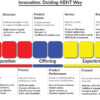
Entering the stock market is akin to traversing a complex labyrinth, filled with unexpected turns and hidden pathways. Success in this intricate world requires not just courage but also a deep understanding of macroeconomics, market dynamics, and fundamental analysis. This comprehensive knowledge acts as your guiding light, helping you make informed decisions and uncover the true potential of investments.
Understanding the Macroeconomic Landscape
The macroeconomic environment is like a backdrop against which the stock market plays out. Key indicators include:
- Gross Domestic Product (GDP): Reflects the overall health of an economy. A growing GDP often suggests a favorable environment for businesses and, subsequently, the stock market.
- Inflation and Interest Rates: Managed by central banks, these factors influence borrowing costs and investment decisions, thereby impacting stock valuations.
- Unemployment Rate: High unemployment can signal a weak economy, potentially affecting consumer spending and corporate earnings.
- Government Policies: Fiscal and monetary decisions can significantly shape economic landscapes and market trajectories.
Market Knowledge: Understanding the Intricacies
The stock market has its language and mechanisms. Familiarity with concepts like bull and bear markets, technical and fundamental analysis, and the importance of diversification is crucial. These concepts help investors decode market signals and make strategic investment decisions.
Fundamental Analysis: The Flashlight in the Dark
- Fundamental analysis involves a deep dive into a company’s financial health and market position. Key aspects include:
- Consistent Revenue Growth: This indicates market demand and sustainable business operations.
- Healthy Profit Margins: Efficient profit generation is a marker of a company’s long-term viability.
- Low Debt Levels: Companies burdened by high debt are riskier, especially in economic downturns.
- Robust Cash Flow: Strong cash flow signals a company’s ability to invest in growth and weather financial storms.
Valuation Metrics: Identifying Undervalued Stock
Ratios like Price-to-Earnings (P/E), Price-to-Book (P/B), and Price-to-Sales (P/S) are vital in assessing BIG FIVE METRICS and whether a stock is undervalued or overvalued compared to its peers.
The Importance of Industry Leadership and Dividend History
Investing in industry leaders can offer safety during market volatility. Furthermore, a consistent and growing dividend history is often a sign of a company’s financial health and stability.
Learning from the Past: Historical Performance and Management Quality
While past performance is not an absolute predictor, companies that have shown resilience during economic downturns can be safer bets. Effective and transparent management is also crucial for long-term value creation.

Sectoral Analysis for a Balanced Portfolio
Certain sectors, like healthcare and utilities, offer stability and consistent growth, making them safer investment choices compared to more volatile sectors. However, diversification across various sectors and asset classes is key to mitigating risks.
Indian Market Examples
In the Indian context, companies like Reliance Industries, TCS, and HDFC Bank have demonstrated strong fundamentals over time. Their robust growth, sound financials, and visionary leadership have made them favorites among investors. On the other hand, sectors like IT and Pharmaceuticals have shown resilience and consistent growth, making them attractive for long-term investment.
Grand Finale
Scrutinizing the stock market is a multifaceted journey. It requires a blend of macroeconomic understanding, market knowledge, and the ability to perform fundamental analysis. By arming yourself with this comprehensive knowledge, staying abreast of global and local economic trends, and conducting thorough company and sector analyses, you can increase your chances of success in the stock market.
As Warren Buffett rightly said, “It’s far better to buy a wonderful company at a fair price than a fair company at a wonderful price.” This wisdom encapsulates the essence of successful stock market investment – it’s about quality, patience, and informed decision-making. So, embark on this journey with your toolkit of knowledge, and let your investment choices reflect your understanding and insights.
Next: Moxie-ism: The Art of Risk and Reward in the Stock Market.
Prof. Dr. Prahlada N. B
16 December 2023
Chitradurga.

















[…] Next: Market Maze: Essential Macroeconomics, Market Knowledge, and Fundamental Analysis. […]
ReplyGood information for beginners
ReplyPrahlada Sir,
What I have understood about macro-economics is as below :
The 'macro-economics-environment'…..actually refers to the broader condition of an economy as opposed to 'specific markets'.
As vividly told by you, The macro-economics-environment can be affected by GDP, fiscal policy, monetory policy, inflation, employment rates & consumer spending.
Reply